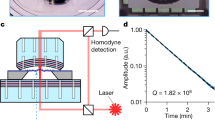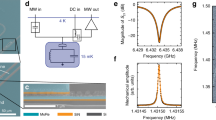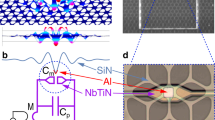Abstract
Demonstrating and exploiting the quantum nature of macroscopic mechanical objects would help us to investigate directly the limitations of quantum-based measurements and quantum information protocols, as well as to test long-standing questions about macroscopic quantum coherence1,2,3. Central to this effort is the necessity of long-lived mechanical states. Previous efforts have witnessed quantum behaviour4, but for a low-quality-factor mechanical system. The field of cavity optomechanics and electromechanics5,6, in which a high-quality-factor mechanical oscillator is parametrically coupled to an electromagnetic cavity resonance, provides a practical architecture for cooling, manipulation and detection of motion at the quantum level1. One requirement is strong coupling7,8,9, in which the interaction between the two systems is faster than the dissipation of energy from either system. Here, by incorporating a free-standing, flexible aluminium membrane into a lumped-element superconducting resonant cavity, we have increased the single-photon coupling strength between these two systems by more than two orders of magnitude, compared to previously obtained coupling strengths. A parametric drive tone at the difference frequency between the mechanical oscillator and the cavity resonance dramatically increases the overall coupling strength, allowing us to completely enter the quantum-enabled, strong-coupling regime. This is evidenced by a maximum normal-mode splitting of nearly six bare cavity linewidths. Spectroscopic measurements of these ‘dressed states’ are in excellent quantitative agreement with recent theoretical predictions10,11. The basic circuit architecture presented here provides a feasible path to ground-state cooling and subsequent coherent control and measurement of long-lived quantum states of mechanical motion.
This is a preview of subscription content, access via your institution
Access options
Subscribe to this journal
Receive 51 print issues and online access
$199.00 per year
only $3.90 per issue
Buy this article
- Purchase on Springer Link
- Instant access to full article PDF
Prices may be subject to local taxes which are calculated during checkout




Similar content being viewed by others
References
Braginsky, V. B. & Khalili, F. Y. Quantum Measurement (Cambridge Univ. Press, 1992)
Mancini, S., Man'ko, V. I. & Tombesi, P. Ponderomotive control of quantum macroscopic coherence. Phys. Rev. A 55, 3042–3050 (1997)
Bose, S., Jacobs, K. & Knight, P. L. Preparation of nonclassical states in cavities with a moving mirror. Phys. Rev. A 56, 4175–4186 (1997)
O'Connell, A. D. et al. Quantum ground state and single-phonon control of a mechanical resonator. Nature 464, 697–703 (2010)
Kippenberg, T. J. & Vahala, K. J. Cavity optomechanics: back-action at the mesoscale. Science 321, 1172–1176 (2008)
Marquardt, F. & Girvin, S. M. Optomechanics. Physics 2, 40 (2009)
Marquardt, F., Chen, J. P., Clerk, A. A. & Girvin, S. M. Quantum theory of cavity-assisted sideband cooling of mechanical motion. Phys. Rev. Lett. 99, 093902 (2007)
Wilson-Rae, I., Nooshi, N., Zwerger, W. & Kippenberg, T. J. Theory of ground state cooling of a mechanical oscillator using dynamical backaction. Phys. Rev. Lett. 99, 093901 (2007)
Dobrindt, J. M., Wilson-Rae, I. & Kippenberg, T. J. Parametric normal-mode splitting in cavity optomechanics. Phys. Rev. Lett. 101, 263602 (2008)
Agarwal, G. S. & Huang, S. Electromagnetically induced transparency in mechanical effects of light. Phys. Rev. A 81, 041803 (2010)
Weis, S. et al. Optomechanically induced transparency. Science 330, 1520–1523 (2010)
Ekinci, K. L. & Roukes, M. L. Nanoelectromechanical systems. Rev. Sci. Instrum. 76, 061101 (2005)
Diedrich, F., Bergquist, J. C., Itano, W. M. & Wineland, D. J. Laser cooling to the zero-point energy of motion. Phys. Rev. Lett. 62, 403–406 (1989)
Gröblacher, S., Hammerer, K., Vanner, M. R. & Aspelmeyer, M. Observation of strong coupling between a micromechanical resonator and an optical cavity field. Nature 460, 724–727 (2009)
Thompson, J. D. et al. Strong dispersive coupling of a high-finesse cavity to a micromechanical membrane. Nature 452, 72–75 (2008)
Braginsky, V. B., Manukin, A. B. & Tikhonov, M. Y. Investigation of dissipative ponderomotive effects of electromagnetic radiation. Sov. Phys. JETP 31, 829–830 (1970)
Linthorne, N. P., Veitch, P. J. & Blair, D. G. Interaction of a parametric transducer with a resonant bar gravitational radiation detector. J. Phys. D 23, 1–6 (1990)
Regal, C. A., Teufel, J. D. & Lehnert, K. W. Measuring nanomechanical motion with a microwave cavity interferometer. Nature Phys. 4, 555–560 (2008)
Teufel, J. D., Harlow, J. W., Regal, C. A. & Lehnert, K. W. Dynamical backaction of microwave fields on a nanomechanical oscillator. Phys. Rev. Lett. 101, 197203 (2008)
Rocheleau, T. et al. Preparation and detection of a mechanical resonator near the ground state of motion. Nature 463, 72–75 (2010)
Teufel, J. D., Donner, T., Castellanos-Beltran, M. A., Harlow, J. W. & Lehnert, K. W. Nanomechanical motion measured with an imprecision below that at the standard quantum limit. Nature Nanotechnol. 4, 820–823 (2009)
Hertzberg, J. B. et al. Back-action-evading measurements of nanomechanical motion. Nature Phys. 6, 213–217 (2010)
Cicak, K. et al. Low-loss superconducting resonant circuits using vacuum-gap-based microwave components. Appl. Phys. Lett. 96, 093502 (2010)
Blencowe, M. P. & Buks, E. Quantum analysis of a linear dc squid mechanical displacement detector. Phys. Rev. B 76, 014511 (2007)
Boller, K.-J., Imamolu, A. & Harris, S. E. Observation of electromagnetically induced transparency. Phys. Rev. Lett. 66, 2593–2596 (1991)
Hofheinz, M. et al. Synthesizing arbitrary quantum states in a superconducting resonator. Nature 459, 546–549 (2009)
Marshall, W., Simon, C., Penrose, R. & Bouwmeester, D. Towards quantum superpositions of a mirror. Phys. Rev. Lett. 91, 130401 (2003)
Castellanos-Beltran, M. A., Irwin, K. D., Hilton, G. C., Vale, L. R. & Lehnert, K. W. Amplification and squeezing of quantum noise with a tunable Josephson metamaterial. Nature Phys. 4, 929–931 (2008)
Akram, U., Kiesel, N., Aspelmeyer, M. & Milburn, G. J. Single-photon opto-mechanics in the strong coupling regime. N. J. Phys. 12, 083030 (2010)
Regal, C. A. & Lehnert, K. W. From cavity electromechanics to cavity optomechanics. J. Phys. Conf. Ser. 264, 012025 (2011)
Acknowledgements
We thank A. W. Sanders for taking the micrograph in Fig. 1b, and acknowledge discussions with T. Donner, J. H. Harlow and K. W. Lehnert. This paper is a contribution by the National Institute of Standards and Technology and not subject to US copyright.
Author information
Authors and Affiliations
Contributions
J.D.T. and R.W.S. conceived the device. J.D.T. designed the circuit. J.D.T. and D.L. fabricated the devices. J.D.T. performed and analysed the measurements. R.W.S. oversaw all aspects of this work. All authors provided experimental support and commented on the manuscript.
Corresponding author
Ethics declarations
Competing interests
The authors declare no competing financial interests.
Rights and permissions
About this article
Cite this article
Teufel, J., Li, D., Allman, M. et al. Circuit cavity electromechanics in the strong-coupling regime. Nature 471, 204–208 (2011). https://doi.org/10.1038/nature09898
Received:
Accepted:
Published:
Issue Date:
DOI: https://doi.org/10.1038/nature09898
This article is cited by
-
Optically heralded microwave photon addition
Nature Physics (2023)
-
Microcavity phonoritons – a coherent optical-to-microwave interface
Nature Communications (2023)
-
A quantum electromechanical interface for long-lived phonons
Nature Physics (2023)
-
Perfect optomechanically induced transparency in two-cavity optomechanics
Frontiers of Physics (2023)
-
Microwave Optomechanically Induced Transparency and Absorption Between 250 and 450 mK
Journal of Low Temperature Physics (2023)
Comments
By submitting a comment you agree to abide by our Terms and Community Guidelines. If you find something abusive or that does not comply with our terms or guidelines please flag it as inappropriate.



